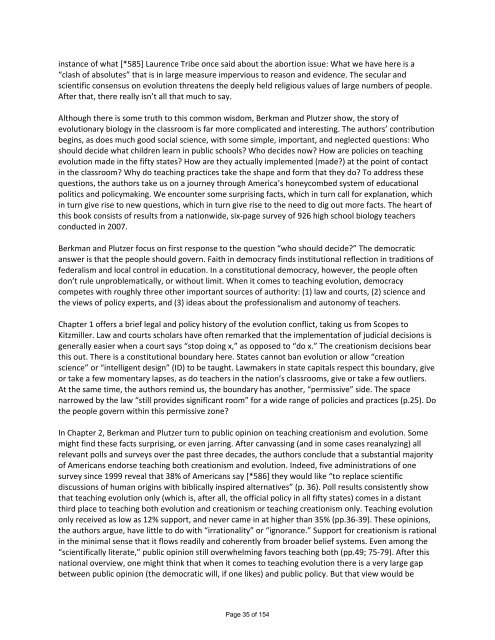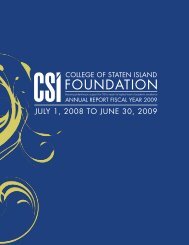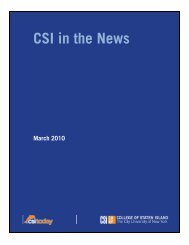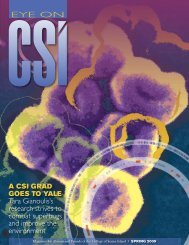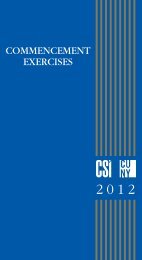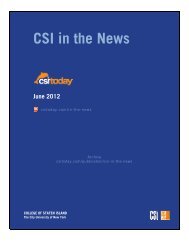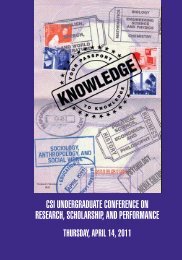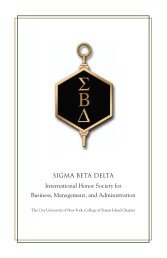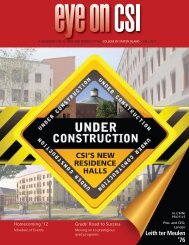Law & Politics Book ReviewSponsored by <strong>the</strong> Law and Courts Section of <strong>the</strong> American Political Science AssociationEVOLUTION, CREATIONISM, AND THE BATTLE TO CONTROLAMERICA’S CLASSROOMSby Michael Berkman and Eric Plutzer. New York, NY: Cambridge University Press, 2010.304pp. Hardback. $85.00/£50.00. ISBN: 9780521190466. Paperback. $27.99/£17.99. ISBN:9780521148863. Adobe eBook. $22.00. ISBN: 9780511922251.pp. 584‐590Reviewed by Michal Paris, Political Science, The College of Staten Island (CUNY). Email:Michael.Paris [at] csi.cuny.edu.“No scientific generalization is more strongly supported by thoroughly tested [evidence] than is that oforganic evolution.” So said a resolution of <strong>the</strong> American Association for <strong>the</strong> Advancement of Science <strong>in</strong><strong>the</strong> year 1922. Yet, as is well known, shortly <strong>the</strong>reafter, <strong>in</strong> 1925, <strong>the</strong>re followed <strong>the</strong> Scopes Monkey Trial.For decades after that, communities across America banished evolution from high school biologyclassrooms. Susan Epperson’s successful establishment clause challenge to an Arkansas law that made itunlawful to teach Darw<strong>in</strong>ian evolution did not end <strong>the</strong> controversy <strong>in</strong> 1968. Nor did Don Aguillard’ssuccessful attack on a Louisiana law that required “balanced treatment” for “creation science” and“evolution” end it <strong>in</strong> 1987. Still, <strong>in</strong> <strong>the</strong> 1990’s, <strong>the</strong> national guardians of modern science <strong>in</strong> publiceducation – for example, <strong>the</strong> National Academy of Science’s National Research Council – might havereasonably thought that <strong>the</strong>y were pound<strong>in</strong>g nails <strong>in</strong> <strong>the</strong> coff<strong>in</strong> when <strong>the</strong>y po<strong>in</strong>tedly argued that <strong>the</strong>scientific case for evolution had grown stronger by <strong>the</strong> decade, and that evolution was scientific fact,pure and simple, and not merely a hunch, an idea, or even “a <strong>the</strong>ory” (Berkman and Plutzer, pp.14‐15;99‐101; 145). But anti‐evolutionism <strong>in</strong> America is like <strong>the</strong> wounded soldier who suffers defeat only toreturn to <strong>the</strong> fight with enhanced ardor (p.98, <strong>in</strong>ternal citation omitted). And so “scientific creationism”soon morphed <strong>in</strong>to “<strong>in</strong>telligent design,” and controversies over evolution and state education standardserupted aga<strong>in</strong>, most notably <strong>in</strong> Kansas and Florida. In Dover, Pennsylvania <strong>in</strong> 2004, <strong>the</strong>re were echoes<strong>the</strong> Scopes Monkey Trial when <strong>the</strong> compet<strong>in</strong>g sides faced off <strong>in</strong> federal court <strong>in</strong> <strong>the</strong> Kitzmiller case. Aconservative judge nom<strong>in</strong>ated by George W. Bush dealt <strong>the</strong> anti‐evolutionists yet ano<strong>the</strong>r st<strong>in</strong>g<strong>in</strong>g legaldefeat.Why is <strong>the</strong>re an ongo<strong>in</strong>g political controversy when, accord<strong>in</strong>g to an overwhelm<strong>in</strong>g scientific consensusbased on overwhelm<strong>in</strong>g empirical evidence, <strong>the</strong>re should be no controversy? What expla<strong>in</strong>s “<strong>the</strong>amaz<strong>in</strong>g durability of this conflict on <strong>the</strong> American scene” (p.3)? In this book, Berkman and Plutzer setout to unpack this puzzle and illum<strong>in</strong>ate its multiple strands. They succeed. This is a very f<strong>in</strong>e and nicelycrafted book. It will be impossible here to do justice to <strong>the</strong> authors’ social scientific creativity andnuanced argument.Most readers will approach <strong>the</strong> creationism/evolution controversy with <strong>the</strong> sense that this is onePage 34 of 154
<strong>in</strong>stance of what [*585] Laurence Tribe once said about <strong>the</strong> abortion issue: What we have here is a“clash of absolutes” that is <strong>in</strong> large measure impervious to reason and evidence. The secular andscientific consensus on evolution threatens <strong>the</strong> deeply held religious values of large numbers of people.After that, <strong>the</strong>re really isn’t all that much to say.Although <strong>the</strong>re is some truth to this common wisdom, Berkman and Plutzer show, <strong>the</strong> story ofevolutionary biology <strong>in</strong> <strong>the</strong> classroom is far more complicated and <strong>in</strong>terest<strong>in</strong>g. The authors’ contributionbeg<strong>in</strong>s, as does much good social science, with some simple, important, and neglected questions: Whoshould decide what children learn <strong>in</strong> public schools? Who decides now? How are policies on teach<strong>in</strong>gevolution made <strong>in</strong> <strong>the</strong> fifty states? How are <strong>the</strong>y actually implemented (made?) at <strong>the</strong> po<strong>in</strong>t of contact<strong>in</strong> <strong>the</strong> classroom? Why do teach<strong>in</strong>g practices take <strong>the</strong> shape and form that <strong>the</strong>y do? To address <strong>the</strong>sequestions, <strong>the</strong> authors take us on a journey through America’s honeycombed system of educationalpolitics and policymak<strong>in</strong>g. We encounter some surpris<strong>in</strong>g facts, which <strong>in</strong> turn call for explanation, which<strong>in</strong> turn give rise to new questions, which <strong>in</strong> turn give rise to <strong>the</strong> need to dig out more facts. The heart ofthis book consists of results from a nationwide, six‐page survey of 926 high school biology teachersconducted <strong>in</strong> 2007.Berkman and Plutzer focus on first response to <strong>the</strong> question “who should decide?” The democraticanswer is that <strong>the</strong> people should govern. Faith <strong>in</strong> democracy f<strong>in</strong>ds <strong>in</strong>stitutional reflection <strong>in</strong> traditions offederalism and local control <strong>in</strong> education. In a constitutional democracy, however, <strong>the</strong> people oftendon’t rule unproblematically, or without limit. When it comes to teach<strong>in</strong>g evolution, democracycompetes with roughly three o<strong>the</strong>r important sources of authority: (1) law and courts, (2) science and<strong>the</strong> views of policy experts, and (3) ideas about <strong>the</strong> professionalism and autonomy of teachers.Chapter 1 offers a brief legal and policy history of <strong>the</strong> evolution conflict, tak<strong>in</strong>g us from Scopes toKitzmiller. Law and courts scholars have often remarked that <strong>the</strong> implementation of judicial decisions isgenerally easier when a court says “stop do<strong>in</strong>g x,” as opposed to “do x.” The creationism decisions bearthis out. There is a constitutional boundary here. States cannot ban evolution or allow “creationscience” or “<strong>in</strong>telligent design” (ID) to be taught. Lawmakers <strong>in</strong> state capitals respect this boundary, giveor take a few momentary lapses, as do teachers <strong>in</strong> <strong>the</strong> nation’s classrooms, give or take a few outliers.At <strong>the</strong> same time, <strong>the</strong> authors rem<strong>in</strong>d us, <strong>the</strong> boundary has ano<strong>the</strong>r, “permissive” side. The spacenarrowed by <strong>the</strong> law “still provides significant room” for a wide range of policies and practices (p.25). Do<strong>the</strong> people govern with<strong>in</strong> this permissive zone?In Chapter 2, Berkman and Plutzer turn to public op<strong>in</strong>ion on teach<strong>in</strong>g creationism and evolution. Somemight f<strong>in</strong>d <strong>the</strong>se facts surpris<strong>in</strong>g, or even jarr<strong>in</strong>g. After canvass<strong>in</strong>g (and <strong>in</strong> some cases reanalyz<strong>in</strong>g) allrelevant polls and surveys over <strong>the</strong> past three decades, <strong>the</strong> authors conclude that a substantial majorityof Americans endorse teach<strong>in</strong>g both creationism and evolution. Indeed, five adm<strong>in</strong>istrations of onesurvey s<strong>in</strong>ce 1999 reveal that 38% of Americans say [*586] <strong>the</strong>y would like “to replace scientificdiscussions of human orig<strong>in</strong>s with biblically <strong>in</strong>spired alternatives” (p. 36). Poll results consistently showthat teach<strong>in</strong>g evolution only (which is, after all, <strong>the</strong> official policy <strong>in</strong> all fifty states) comes <strong>in</strong> a distantthird place to teach<strong>in</strong>g both evolution and creationism or teach<strong>in</strong>g creationism only. Teach<strong>in</strong>g evolutiononly received as low as 12% support, and never came <strong>in</strong> at higher than 35% (pp.36‐39). These op<strong>in</strong>ions,<strong>the</strong> authors argue, have little to do with “irrationality” or “ignorance.” Support for creationism is rational<strong>in</strong> <strong>the</strong> m<strong>in</strong>imal sense that it flows readily and coherently from broader belief systems. Even among <strong>the</strong>“scientifically literate,” public op<strong>in</strong>ion still overwhelm<strong>in</strong>g favors teach<strong>in</strong>g both (pp.49; 75‐79). After thisnational overview, one might th<strong>in</strong>k that when it comes to teach<strong>in</strong>g evolution <strong>the</strong>re is a very large gapbetween public op<strong>in</strong>ion (<strong>the</strong> democratic will, if one likes) and public policy. But that view would bePage 35 of 154
- Page 1 and 2: CSI in the NewsOctober 2011csitoday
- Page 3 and 4: ADSPage 3 of 154
- Page 7 and 8: The sound of music aboundsSunday, O
- Page 9 and 10: serving dessert, cheese, wine and c
- Page 11 and 12: Dance teachers will walk the red ca
- Page 13 and 14: Page 13 of 154
- Page 15 and 16: "The police put out the fire and to
- Page 17 and 18: A second guesthouse owner said his
- Page 19 and 20: College of Staten Island adjunct pr
- Page 21 and 22: 10/05/2011 10:01 AMCSI Adjunct Nabb
- Page 23 and 24: Latinos, these physicians still mus
- Page 25 and 26: THURSDAY, OCTOBER 13, 2011Granitevi
- Page 27 and 28: ocks have swaths of paint on them w
- Page 29 and 30: Nurses rose to the challenge during
- Page 31 and 32: oth directly, by inducting them int
- Page 33: the value of participation in democ
- Page 37 and 38: spent each year covering “evoluti
- Page 39 and 40: level, would want to take a close l
- Page 41 and 42: Page 41 of 154
- Page 43 and 44: favor of Soliman. The case was appe
- Page 45 and 46: Real estate. John M. Rodriguez v. C
- Page 48 and 49: percent of them are in New Jersey.B
- Page 50 and 51: SportsPage 50 of 154
- Page 52: Lightning's Thiam Leads Strike for
- Page 55 and 56: CUNYAC/Hospital For Special Surgery
- Page 57 and 58: CUNYAC/US Army Women’s Cross Coun
- Page 59 and 60: lines, hash marks or numbers, causi
- Page 61 and 62: CUNYAC Photographer/Baruch Student
- Page 63 and 64: come back and tie the match, 8‐8.
- Page 65 and 66: CSI men lose soccer decision to St.
- Page 67 and 68: Still to maintain her hectic schedu
- Page 69 and 70: Dolphins ace FDU-Florham in 8-1 soc
- Page 71 and 72: CUNYAC/US Army Men’s Cross Countr
- Page 73 and 74: CUNYAC/US Army Women’s Cross Coun
- Page 75 and 76: CSI women lock up top spot in socce
- Page 77 and 78: Staten Island sports bulletin board
- Page 79 and 80: Morales, who became CSI president i
- Page 81 and 82: Playing at number 1 doubles, Orkis
- Page 83 and 84: Women's Swimmer Alyssa Lubrino is S
- Page 85 and 86:
Rain takes toll on Staten Island sp
- Page 87 and 88:
CSI women's tennis season done with
- Page 89 and 90:
John Jay's Brenda Pitts Seizes CUNY
- Page 91 and 92:
CSI honor roll of athletes grew to
- Page 93 and 94:
Caifa, Orsi Bermudez Reyes, Stephen
- Page 95 and 96:
CUNYAC / Applebee's Men's Soccer Se
- Page 97 and 98:
StoriesPage 97 of 154
- Page 99 and 100:
Students gather at College of State
- Page 101 and 102:
—New York University—College of
- Page 103 and 104:
to the college, to create a sense o
- Page 105 and 106:
Staten Island resident part of crea
- Page 107 and 108:
Assemblyman Cusick hails youngsters
- Page 109 and 110:
College of Staten Island students r
- Page 111 and 112:
CSI gets some blow-backWednesday, O
- Page 113 and 114:
At CSI, points of light to dispel t
- Page 115 and 116:
Colleges With The Highest Acceptanc
- Page 117 and 118:
Staten Island's MTA board member Al
- Page 119 and 120:
Some no-cost solutions have been ac
- Page 121 and 122:
Staten Island branch of the JDRF.In
- Page 123 and 124:
Monday, October 24, 20112011 CUNY G
- Page 125 and 126:
Hundreds Attend Unidad Latina Confe
- Page 127 and 128:
Dr. Alvaro Carrascal, Senior Vice P
- Page 129 and 130:
what is being done at the governmen
- Page 131 and 132:
Students & AlumniPage 131 of 154
- Page 133 and 134:
Your Soap BoxWednesday, October 12,
- Page 135 and 136:
And he will almost certainly lose i
- Page 137 and 138:
She's giving young immigrants a voi
- Page 139 and 140:
AlumniPage 139 of 154
- Page 141 and 142:
Ms. Frazzetta moved with her husban
- Page 143 and 144:
Sicilian grilling.But she said one
- Page 145 and 146:
October 20, 2011Joanne S. Calcagno
- Page 147 and 148:
UFT endorses Donovan in Staten Isla
- Page 149 and 150:
“When the Lightning won the Stanl
- Page 151 and 152:
Patch Elections 2011: County Legisl
- Page 153 and 154:
fix that is shortsighted. Also, los


